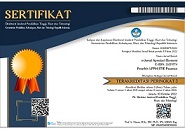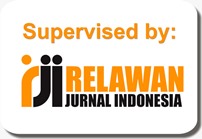THE IMPACT OF FEAR OF MISSING OUT ON OBSESSIVE-COMPULSIVE BUYING BEHAVIOR: EXPLORING THE ROLE OF BRAND PASSION (AMONG GENERATION Z IN PEKANBARU CITY)
Abstract
Keywords: Fear of Missing Out (FoMO), Harmonious Brand Passion, Obsessive Brand Passion, Obsessive-Compulsive Buying
Full Text:
PDFReferences
Almuttaqin, M. A., & Nur, N. M. (2023). The Influence of The Money Supply on The Inflation Rate in Indonesia for The 2010-2020 Period. Management Studies and Entrepreneurship Journal, 4(2), 1061–1068. http://journal.yrpipku.com/index.php/msej
Aydin, D., Selvi, Y., Kandeger, A., & Boysan, M. (2021). The relationship of consumers’ compulsive buying behavior with biological rhythm, impulsivity, and fear of missing out. Biological Rhythm Research, 52(10), 1514–1522. https://doi.org/10.1080/09291016.2019.1654203
Batra, R., Ahuvia, A., & Bagozzi, R. P. (2012). Brand love. Journal of Marketing, 76(2), 1–16. https://doi.org/10.1509/jm.09.0339
Brailovskaia, J., Ozimek, P., Elke, R., & Bierhoff, H.-W. (2023). Vulnerable narcissism, fear of missing out (FoMO) and addictive social media use: A gender comparison from Germany. Computers in Human Behavior, 144. https://doi.org/https://doi.org/10.1016/j.chb.2023.107725
Carol Ann Frost, by, Blouin, M., Cantor, R., Chung, K., Dawson, P., Griep, C., Grossman, R., Gu, F., Hand, J., Huefner, R., Jiang, J., Kim, M., Levin, A., Rogers, R., Shakespeare, C., Verde, M., Ziebart, D., Bigelsen, E., Bolger, R., … Stewart, N. (2006). Credit Rating Agencies in Capital Markets: A Review of Research Evidence on Selected Criticisms of the Agencies Acknowledgements I am grateful for helpful comments and suggestions from Credit Rating Agencies in Capital Markets: A Review of Research Eviden.
Christenson, G. A., MacKenzie, T. B., & Mitchell, J. E. (1994). Adult Men and Women With Trichotilomania: A Comparison of Male and Female Characteristics. Psychosomatics, 35(2), 142–149. https://doi.org/10.1016/S0033-3182(94)71788-6
Csikszentmihalyi, M., & Figurski, T. J. (1982). Self‐awareness and aversive experience in everyday life. Journal of Personality, 50(1), 15–19. https://doi.org/10.1111/j.1467-6494.1982.tb00742.x
Curran, T., Hill, A. P., Appleton, P. R., Vallerand, R. J., & Standage, M. (2015). The psychology of passion: A meta-analytical review of a decade of research on intrapersonal outcomes. In Motivation and Emotion (Vol. 39, Issue 5). https://doi.org/10.1007/s11031-015-9503-0
Darrat, A. A., Darrat, M. A., & Amyx, D. (2016). How impulse buying influences compulsive buying: The central role of consumer anxiety and escapism. Journal of Retailing and Consumer Services, 31, 103–108. https://doi.org/10.1016/j.jretconser.2016.03.009
Deci, E. L., & Ryan, R. M. (1987). The Support of Autonomy and the Control of Behavior. Journal of Personality and Social Psychology, 53(6), 1024–1037. https://doi.org/10.1037/0022-3514.53.6.1024
Dittmar, H. (2005). A new look at “compulsive buying”: Self-discrepancies and materialistic values as predictors of compulsive buying tendency. Journal of Social and Clinical Psychology, 24(6), 832–859. https://doi.org/10.1521/jscp.2005.24.6.832
Dittmar, H., Beattie, J., & Friese, S. (1995). Gender identity and material symbols : Objects and decision considerations in impulse purchases. 16, 491–511.
Elhai, J. D., Levine, J. C., Alghraibeh, A. M., Alafnan, A. A., Aldraiweesh, A. A., & Hall, B. J. (2018). Fear of missing out: Testing relationships with negative affectivity, online social engagement, and problematic smartphone use. Computers in Human Behavior, 89(August), 289–298. https://doi.org/10.1016/j.chb.2018.08.020
Elhai, J. D., Levine, J. C., Dvorak, R. D., & Hall, B. J. (2016). Fear of missing out, need for touch, anxiety and depression are related to problematic smartphone use. Computers in Human Behavior, 63, 509–516. https://doi.org/10.1016/j.chb.2016.05.079
Festinger, L. (1954). A Theory of Social Comparison Processes. Human Relations, 7(2), 117–140. https://doi.org/10.1177/001872675400700202
Gilal, F. G., Paul, J., Gilal, R. G., & Gilal, N. G. (2023). Advancing basic psychological needs theory in marketing research. In International Journal of Market Research (Vol. 65, Issue 6). https://doi.org/10.1177/14707853231184740
Harrison-Walker, L. J., & Mead, J. A. (2024). Exploring the fear of missing out (FOMO) and customer bonds in service relationships. Journal of Services Marketing, 38(5), 636–655. https://doi.org/10.1108/JSM-07-2023-0261
Henseler, J., Ringle, C. M., & Sarstedt, M. (2016). Testing measurement invariance of composites using partial least squares. International Marketing Review, 33(3), 405–431. https://doi.org/10.1108/IMR-09-2014-0304
Hodkinson, C. (2019). ‘Fear of Missing Out’ (FOMO) marketing appeals: A conceptual model. Journal of Marketing Communications, 25(1), 65–88. https://doi.org/10.1080/13527266.2016.1234504
Holte, A. J., & Ferraro, F. R. (2020). Anxious, bored, and (maybe) missing out: Evaluation of anxiety attachment, boredom proneness, and fear of missing out (FoMO). Computers in Human Behavior, 112(June), 106465. https://doi.org/10.1016/j.chb.2020.106465
Honora, A., Wang, K. Y., & Chih, W. H. (2024). Gaining customer engagement in social media recovery: the moderating roles of timeliness and personalization. Internet Research, February. https://doi.org/10.1108/INTR-06-2022-0439
Horváth, C., & Ad, F. (2024). Shopping enjoyment to the extreme : Hedonic shopping motivations and compulsive buying in developed and emerging markets Doi link to publisher : https://doi.org/10.1016/j.jbusres.2017.07.013 Version of the following full text : Publisher ’ s version Publi. 2018, 300–310.
Hussain, S., Raza, A., Haider, A., Ishaq, M. I., & Talpur, Q. (2023). Fear of missing out and compulsive buying behavior: The moderating role of mindfulness. Journal of Retailing and Consumer Services, 75, 103512. https://doi.org/https://doi.org/10.1016/j.jretconser.2023.103512
Japutra, A., Ekinci, Y., & Simkin, L. (2019). Self-congruence, brand attachment and compulsive buying. Journal of Business Research, 99, 456–463. https://doi.org/10.1016/j.jbusres.2017.08.024
Japutra, A., Ekinci, Y., & Simkin, L. (2022). Discovering the dark side of brand attachment: Impulsive buying, obsessive-compulsive buying and trash talking. Journal of Business Research, 145(March), 442–453. https://doi.org/10.1016/j.jbusres.2022.03.020
Japutra, A., Gordon-Wilson, S., Ekinci, Y., & Adams, E. D. (2024). The dark side of brands: Exploring fear of missing out, obsessive brand passion, and compulsive buying. Journal of Business Research, 186(January 2024), 114990. https://doi.org/10.1016/j.jbusres.2024.114990
Japutra, A., & Song, Z. (2020). Mindsets, shopping motivations and compulsive buying: Insights from China. Journal of Consumer Behaviour, 19(5), 423–437. https://doi.org/10.1002/cb.1821
Karimkhan, F., & Chapa, S. (2021). Is fear of missing out (Fomo) a cultural construct? investigating fomo from a marketing perspective. Journal of Cultural Marketing Strategy, 5(2), 169–183. https://doi.org/10.69554/gzxp2281
Kasser, T. (2016). Materialistic values and goals. Annual Review of Psychology, 67, 489–514. https://doi.org/10.1146/annurev-psych-122414-033344
Kyrios, M., Fassnacht, D. B., Ali, K., Maclean, B., & Moulding, R. (2020). Predicting the severity of excessive buying using the Excessive Buying Rating Scale and Compulsive Buying Scale. Journal of Obsessive-Compulsive and Related Disorders, 25(January), 100509. https://doi.org/10.1016/j.jocrd.2020.100509
Kyrios, M., Mogan, C., Moulding, R., Frost, R. O., Yap, K., & Fassnacht, D. B. (2018). The cognitive–behavioural model of hoarding disorder: Evidence from clinical and non-clinical cohorts. Clinical Psychology and Psychotherapy, 25(2), 311–321. https://doi.org/10.1002/cpp.2164
Latan, H., & Ghozali, I. (2017). Partial Least Squares, Konsep, Metode dan Aplikasi, Program WarpPLS 5.0. universitas diponegoro.
Le, M. T. H. (2021). Correction to: Compulsive buying of brands, its antecedents, and the mediating role of brand love: insights from Vietnam. Current Psychology, 40(9), 4299. https://doi.org/10.1007/s12144-021-02038-2
Lee, J. E., & Watkins, B. (2016). YouTube vloggers’ influence on consumer luxury brand perceptions and intentions. Journal of Business Research, 69(12), 5753–5760. https://doi.org/10.1016/j.jbusres.2016.04.171
Maccarrone-Eaglen, A., & Schofield, P. (2017). Compulsive buying behavior: Re-evaluating its dimensions and screening. Journal of Consumer Behaviour, 16(5), 463–473. https://doi.org/10.1002/cb.1652
Mageau, G. A., Carpentier, J., & Vallerand, R. J. (2011). The role of self-esteem contingencies the distinction between obsessive and harmonious passion. European Journal of Social Psychology, 41(6), 720–729. https://doi.org/10.1002/ejsp.798
Mageau, G. A., Vallerand, R. J., Charest, J., Salvy, S. J., Lacaille, N., Bouffard, T., & Koestner, R. (2009). On the development of harmonious and obsessive passion: The role of autonomy support, activity specialization, and identification with the activity. Journal of Personality, 77(3), 601–646. https://doi.org/10.1111/j.1467-6494.2009.00559.x
McElroy, S. L., Keck, P. E., Pope, H. G., Smith, J. M., & Strakowski, S. M. (1994). Compulsive buying: a report of 20 cases. The Journal of Clinical Psychiatry, 55(6), 242–248.
Miao, L., & Mattila, A. S. (2013). The Impact of Other Customers on Customer Experiences: A Psychological Distance Perspective. Journal of Hospitality and Tourism Research, 37(1), 77–99. https://doi.org/10.1177/1096348011425498
Miltenberger, R. G., Redlin, J., Crosby, R., Stickney, M., Mitchell, J., Wonderlich, S., Faber, R., & Smyth, J. (2003). Direct and retrospective assessment of factors contributing to compulsive buying. Journal of Behavior Therapy and Experimental Psychiatry, 34(1), 1–9. https://doi.org/10.1016/S0005-7916(03)00002-8
Müller, A., Brand, M., Claes, L., Demetrovics, Z., De Zwaan, M., Fernández-Aranda, F., Frost, R. O., Jimenez-Murcia, S., Lejoyeux, M., Steins-Loeber, S., Mitchell, J. E., Moulding, R., Nedeljkovic, M., Trotzke, P., Weinstein, A., & Kyrios, M. (2019). Buying-shopping disorder - Is there enough evidence to support its inclusion in ICD-11? CNS Spectrums, 24(4), 374–379. https://doi.org/10.1017/S1092852918001323
Müller, J., Polakowski, P., Mueller, S., & Mikolajick, T. (2015). Ferroelectric Hafnium Oxide Based Materials and Devices: Assessment of Current Status and Future Prospects. ECS Journal of Solid State Science and Technology, 4(5), N30–N35. https://doi.org/10.1149/2.0081505jss
Mussweiler, T., & Rüter, K. (2003). What Friends Are for! The Use of Routine Standards in Social Comparison. Journal of Personality and Social Psychology, 85(3), 467–481. https://doi.org/10.1037/0022-3514.85.3.467
Przybylski, A. K., Murayama, K., Dehaan, C. R., & Gladwell, V. (2013). Motivational, emotional, and behavioral correlates of fear of missing out. Computers in Human Behavior, 29(4), 1841–1848. https://doi.org/10.1016/j.chb.2013.02.014
Putri, N. L. D. M. E., Sulhaini, & Saufi, A. (2024). The Effect of Fear of Missing Out on Impulse Buying in the Context of S-Commerce. International Journal of Multicultural and Multireligious Understanding, 11(7), 401–407. http://ijmmu.comhttp//dx.doi.org/10.18415/ijmmu.v11i7.5942
Ridgway, N. M., Kukar-Kinney, M., & Monroe, K. B. (2008). An expanded conceptualization and a new measure of compulsive buying. Journal of Consumer Research, 35(4), 622–639. https://doi.org/10.1086/591108
Roberts, J. A., & David, M. E. (2020). The Social Media Party: Fear of Missing Out (FoMO), Social Media Intensity, Connection, and Well-Being. International Journal of Human-Computer Interaction, 36(4), 386–392. https://doi.org/10.1080/10447318.2019.1646517
Roberts, J. A., & Pirog, S. F. (2004). Personal Goals and Their Role in Consumer Behavior: The Case of Compulsive Buying. Journal of Marketing Theory and Practice, 12(3), 61–73. https://doi.org/10.1080/10696679.2004.11658525
Rozgonjuk, D., Sindermann, C., Elhai, J. D., & Montag, C. (2020). Fear of Missing Out (FoMO) and social media’s impact on daily-life and productivity at work: Do WhatsApp, Facebook, Instagram, and Snapchat Use Disorders mediate that association? Addictive Behaviors, 110(March), 106487. https://doi.org/10.1016/j.addbeh.2020.106487
Sarstedt, M., Ringle, C. M., & Hair, J. F. (2020). Handbook of Market Research. In Handbook of Market Research (Issue July). https://doi.org/10.1007/978-3-319-05542-8
Schellenberg, B. J. I., Bailis, D. S., & Mosewich, A. D. (2016). You have passion, but do you have self-compassion? Harmonious passion, obsessive passion, and responses to passion-related failure. Personality and Individual Differences, 99, 278–285. https://doi.org/10.1016/j.paid.2016.05.003
Schermelleh-Engel, K., Moosbrugger, H., & Müller, H. (2003). Evaluating the fit of structural equation models: Tests of significance and descriptive goodness-of-fit measures. MPR-Online, 8(May 2003), 23–74.
Schiffman L. G. Kanuk L. L. & Wisenblit J. (2007). Consumer behavior (Tenth). Et Cases Enabling Decision, 1–16.
Sekaran, U., & Bougie, R. (2011). Research Methods for Business: A Skill-Building Approach, 6th Edition (Seventh ed). Southern Gate, Chichester, West Sussex: United Kingdom. John Wiley & Sons Ltd.
Swimberghe, K. R., Astakhova, M., & Wooldridge, B. R. (2014). A new dualistic approach to brand passion: Harmonious and obsessive. Journal of Business Research, 67(12), 2657–2665. https://doi.org/10.1016/j.jbusres.2014.04.003
Ueda, J., Yamaguchi, S., Matsuda, Y., Okazaki, K., Morimoto, T., Matsukuma, S., Sasaki, T., & Kishimoto, T. (2021). A Randomized Controlled Trial Evaluating the Effectiveness of a Short Video-Based Educational Program for Improving Mental Health Literacy Among Schoolteachers. Frontiers in Psychiatry, 12(February), 1–9. https://doi.org/10.3389/fpsyt.2021.596293
Vallerand, R. J. (2008). On the psychology of passion: In search of what makes people’s lives most worth living. Canadian Psychology, 49(1), 1–13. https://doi.org/10.1037/0708-5591.49.1.1
Vallerand, R. J., Mageau, G. A., Ratelle, C., Léonard, M., Blanchard, C., Koestner, R., Gagné, M., & Marsolais, J. (2003). Les Passions de 1’Âme: On Obsessive and Harmonious Passion. Journal of Personality and Social Psychology, 85(4), 756–767. https://doi.org/10.1037/0022-3514.85.4.756
Vallerand, R. J., Paquet, Y., Philippe, F. L., & Charest, J. (2010). On the role of passion for work in burnout: A process model. Journal of Personality, 78(1), 289–312. https://doi.org/10.1111/j.1467-6494.2009.00616.x
Wang, C. C., & Yang, H. W. (2008). Passion for online shopping: The influence of personality and compulsive buying. Social Behavior and Personality, 36(5), 693–705. https://doi.org/10.2224/sbp.2008.36.5.693
Ward, J. (2015). The Student’s Guide to Cognitive Neuroscience. In The Student’s Guide to Cognitive Neuroscience. Routledge. https://doi.org/10.4324/9781315742397
DOI: https://doi.org/10.31846/jae.v13i3.990
Refbacks
- There are currently no refbacks.

This work is licensed under a Creative Commons Attribution-NonCommercial-NoDerivatives 4.0 International License.
e-Jurnal Apresiasi Ekonnomi Indexed by:












